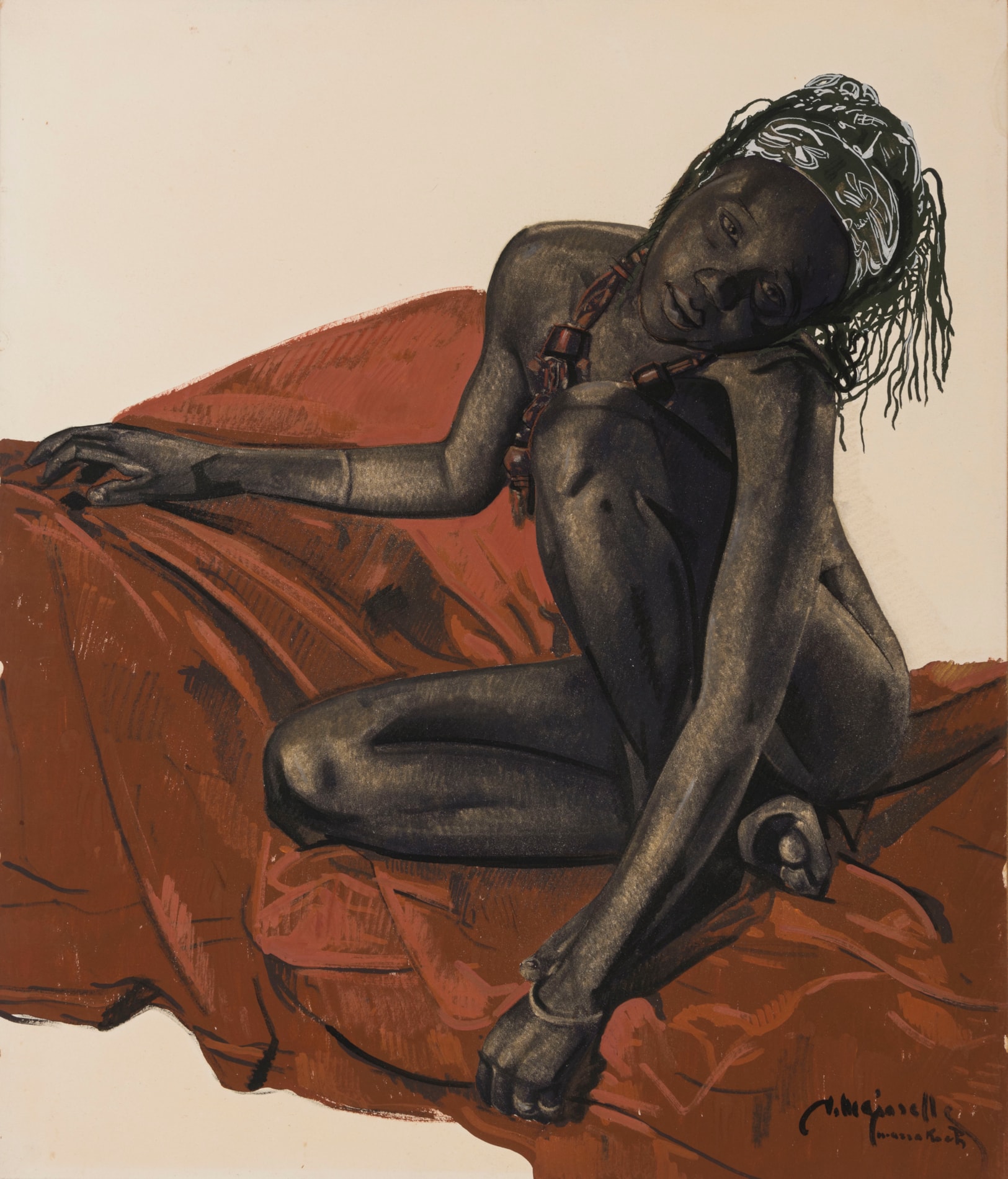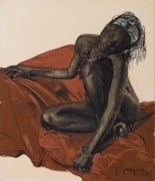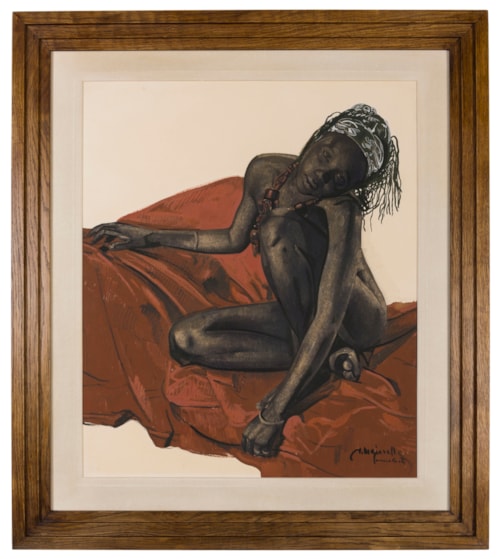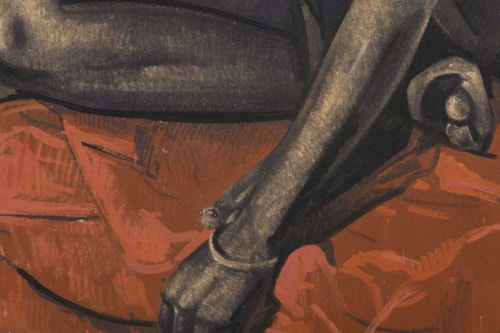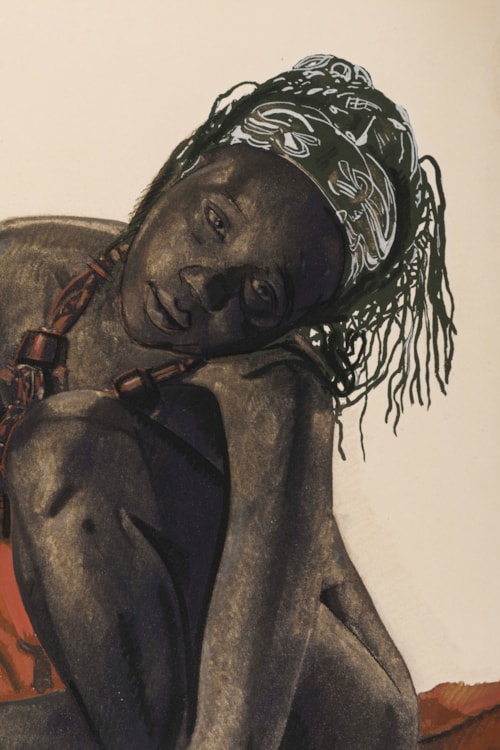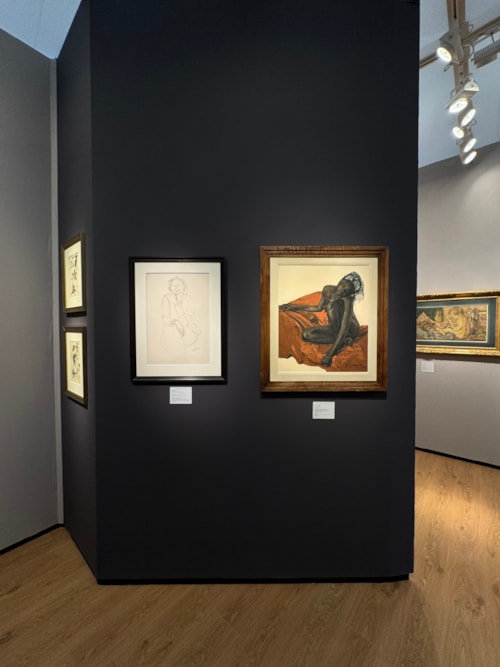Jacques MAJORELLE
(Nancy 1886 - Paris 1962)
Seated Female Nude
Gouache, pastel and metallic powders on paper.
Signed and inscribed J. Majorelle / Marrakech in black ink at the lower right. Inscribed No.17. 28 Flasque et degouttée. on the verso.
Further inscribed No 28 / Flasque et degouttée on a label pasted onto the verso.
634 x 535 mm. (25 x 21 1/8 in.)
Signed and inscribed J. Majorelle / Marrakech in black ink at the lower right. Inscribed No.17. 28 Flasque et degouttée. on the verso.
Further inscribed No 28 / Flasque et degouttée on a label pasted onto the verso.
634 x 535 mm. (25 x 21 1/8 in.)
In the early 1930s Jacques Majorelle began to produce paintings and drawings of African female nudes, sometimes posed amid the luxuriant vegetation of the artist’s garden and at other times in a new studio that the artist had built adjoining the garden. As the Majorelle scholars Félix and Amélie Marcilhac have written, ‘Splendid greenery now surrounded the studio. Shielded from the social events and obligations that his wife always took on, the artist could at last withdraw and work at his painting without hindrance. It had become an entirely separate home, and was a place of personal retreat in which the artist could shut himself away for several days with his models, without going out, to paint them nude away from prying eyes and have them adopt languid, if not suggestive, poses.’
Previously only known from a black and white photograph published on the front page of a Casablanca newspaper in April 1934, the present sheet is a superb example of Majorelle’s nude studies. As Marcilhac has noted of drawings such as this, ‘Technically, in this new series of nudes, his material was reduced. He quite readily used large sheets of paper, sometimes tinted, that he covered in watered-down colours. He then added bright colours that he applied with a brush, mixing them with metallic powders or applying them tentatively on top with his fingers, to give them a more casual design. If the backgrounds were not often sketched out, the human figures, on the other hand, appeared extremely well done and realistic. In the foreground, lying down, sitting, dancing, working or sleeping, whether moving or still, these young girls always expressed an intense, natural joie de vivre that was almost savage…Splendidly rendering their gleaming skin using golden or violet pigments, gold or silver metallic powders mixed with other colours, the painter reproduced all the beauty of their bodies, and gave his compositions a startling impression of life.’ A closely related work on paper, of slightly larger dimensions and horizontal format and showing the same model in a very similar pose, is in a private collection.
The first owner of the present sheet was the French banker Paul-Eugène Sombsthay (1894-1964), a native of Alsace who had settled in Marrakesh not long after Morocco became a French protectorate in 1912. Serving as the director of the Crédit foncier d’Algérie et de Tunisie, Sombsthay befriended his fellow expatriate Majorelle and may have acquired this large work on paper directly from the artist in the 1930s. Included in an exhibition of Majorelle’s work held in April 1934 at the Galerie Derche in Casablanca, this superb drawing has not been exhibited in public since. As a contemporary newspaper account of the Galerie Derche exhibition, which was accompanied by an image of the present sheet, noted, ‘Majorelle has but one landscape painting. All the rest are unique pages of nudes showing African beauty and signifying its simple, childlike soul, with no distraction or over-thinking, this nude soul in full sunlight, with the gaiety and human sweetness of innocence.’
Previously only known from a black and white photograph published on the front page of a Casablanca newspaper in April 1934, the present sheet is a superb example of Majorelle’s nude studies. As Marcilhac has noted of drawings such as this, ‘Technically, in this new series of nudes, his material was reduced. He quite readily used large sheets of paper, sometimes tinted, that he covered in watered-down colours. He then added bright colours that he applied with a brush, mixing them with metallic powders or applying them tentatively on top with his fingers, to give them a more casual design. If the backgrounds were not often sketched out, the human figures, on the other hand, appeared extremely well done and realistic. In the foreground, lying down, sitting, dancing, working or sleeping, whether moving or still, these young girls always expressed an intense, natural joie de vivre that was almost savage…Splendidly rendering their gleaming skin using golden or violet pigments, gold or silver metallic powders mixed with other colours, the painter reproduced all the beauty of their bodies, and gave his compositions a startling impression of life.’ A closely related work on paper, of slightly larger dimensions and horizontal format and showing the same model in a very similar pose, is in a private collection.
The first owner of the present sheet was the French banker Paul-Eugène Sombsthay (1894-1964), a native of Alsace who had settled in Marrakesh not long after Morocco became a French protectorate in 1912. Serving as the director of the Crédit foncier d’Algérie et de Tunisie, Sombsthay befriended his fellow expatriate Majorelle and may have acquired this large work on paper directly from the artist in the 1930s. Included in an exhibition of Majorelle’s work held in April 1934 at the Galerie Derche in Casablanca, this superb drawing has not been exhibited in public since. As a contemporary newspaper account of the Galerie Derche exhibition, which was accompanied by an image of the present sheet, noted, ‘Majorelle has but one landscape painting. All the rest are unique pages of nudes showing African beauty and signifying its simple, childlike soul, with no distraction or over-thinking, this nude soul in full sunlight, with the gaiety and human sweetness of innocence.’
The son of the Art Nouveau cabinetmaker, designer and decorator Louis Majorelle, Jacques Majorelle studied at the École Nationale des Beaux-Arts Appliqués in his native Nancy, initially studying architecture before turning to painting and studying with the gifted artist and draughtsman Emile Friant. In 1906 Majorelle enrolled at the Académie Julian in Paris, a private art school where he remained for about a year, while continuing his occasional studies with Friant, who was now teaching at the Ecole des Beaux-Arts in Paris, although he was not formally enrolled in the school. In 1908 Majorelle travelled to the Pyrenees and Spain, apparently for the sake of his poor health, as he had been diagnosed with early signs of tuberculosis. This was to be the first of the artist’s many journeys outside France. It was also in 1908 that Majorelle first exhibited his work in public, at the Société des Artistes Français in Paris, where he continued to show until 1913. A trip to Venice in the summer of 1909 resulted in a number of paintings that were exhibited in Nancy in January 1910, not long before he made his first visit to Egypt. Majorelle was to make three long trips to Egypt between 1910 and 1914, each stay lasting several months. He often based himself in the small village of Marg, on the Nile near Cairo, and travelled down the river as far as Karnak and Luxor, setting up his easel on the boat.
The next three decades of Majorelle’s life were spent largely in Morocco, and were the most productive of his career. He first arrived in the country in the autumn of 1917, at the age of thirty-one, and after brief stays in the coastal cities of Tangier, Rabat and Casablanca, where he found the damp Atlantic climate difficult for his weak lungs, eventually chose to settl further inland, in Marrakesh, which was to be his home for much of his career. As one writer noted in 1930, ‘All the ragged, intense life of the great city that was both Saharan and Moroccan became familiar to him. Better still, it became his life, the life of his eyes and his artist’s hands.’ Majorelle began to send his Moroccan paintings back to France to be exhibited at galleries in Nancy and in Paris. A show of nearly a hundred paintings of views of Marrakesh and the Atlas mountains was mounted at the Galerie Georges Petit in January 1922, achieving much critical and commercial success, while another exhibition of over sixty Moroccan paintings took place at the Cercle artistique de l’Est in Nancy in 1924. Between 1923 and 1929 Majorelle also designed a number of striking travel posters of Moroccan subjects, for such clients as the Syndicats d’Initiative et de Tourisme du Maroc.
In 1923 the artist acquired a house in Marrakesh, just outside the walls of the Arab city, which he named the Villa Bou Saf Saf, after the Arab word for the poplar trees with which the property was surrounded. A few years later he purchased two adjoining plots of land and created a magnificent walled garden, filled with exotic plants, which was expanded yet again in 1932. (Now known as the Villa Majorelle, the building and its gardens remain one of the leading sights of the city today.) Between 1923 and 1928 he also provided interior decorations for the grand, newly built Hotel La Mamounia in Marrakesh. Majorelle travelled extensively throughout Morocco, painting views of the inland towns and villages and undertaking several expeditions into the mountain areas of the Middle and High Atlas. He established a significant reputation in France as a painter of Orientalist and Near Eastern subjects, and in 1930 published a portfolio reproducing several of his paintings of views in the Atlas mountains, issued in a lavish album entitled Les Kasbahs de l’Atlas and accompanied by an exhibition at the Galerie de La Renaissance in Paris. In 1931 several works by Majorelle decorated in the Moroccan pavilion at the International Colonial Exhibition in Paris. Within a few years, the artist also began to explore a new theme in his work, producing large, sensual paintings of black female nudes. The first public exhibitions of these works, in Rabat in March 1934 and Casablanca the following month, was followed later that year by a large exhibition at the Galerie Jean Charpentier in Paris. The vast majority of the 112 works shown were depictions of female nudes, their ebony skin touched with highlights of metallic powders, and the exhibition attracted considerable acclaim. In 1937 Majorelle painted a pair of very large mural-like canvases of crowded festival scenes for the stairwell of the new Hôtel de Ville in Casablanca, and the following year sent twenty-four paintings to a London gallery as part of an exhibition of three Moroccan-based artists. Between 1945 and 1952 Majorelle made several visits to West Africa in search of new subjects to paint, travelling and working in French Sudan (modern day Mali), Guinea, the Ivory Coast, Niger and Senegal. He continued to live and work in Marrakesh until a few months before his death from leukaemia in 1962.
The next three decades of Majorelle’s life were spent largely in Morocco, and were the most productive of his career. He first arrived in the country in the autumn of 1917, at the age of thirty-one, and after brief stays in the coastal cities of Tangier, Rabat and Casablanca, where he found the damp Atlantic climate difficult for his weak lungs, eventually chose to settl further inland, in Marrakesh, which was to be his home for much of his career. As one writer noted in 1930, ‘All the ragged, intense life of the great city that was both Saharan and Moroccan became familiar to him. Better still, it became his life, the life of his eyes and his artist’s hands.’ Majorelle began to send his Moroccan paintings back to France to be exhibited at galleries in Nancy and in Paris. A show of nearly a hundred paintings of views of Marrakesh and the Atlas mountains was mounted at the Galerie Georges Petit in January 1922, achieving much critical and commercial success, while another exhibition of over sixty Moroccan paintings took place at the Cercle artistique de l’Est in Nancy in 1924. Between 1923 and 1929 Majorelle also designed a number of striking travel posters of Moroccan subjects, for such clients as the Syndicats d’Initiative et de Tourisme du Maroc.
In 1923 the artist acquired a house in Marrakesh, just outside the walls of the Arab city, which he named the Villa Bou Saf Saf, after the Arab word for the poplar trees with which the property was surrounded. A few years later he purchased two adjoining plots of land and created a magnificent walled garden, filled with exotic plants, which was expanded yet again in 1932. (Now known as the Villa Majorelle, the building and its gardens remain one of the leading sights of the city today.) Between 1923 and 1928 he also provided interior decorations for the grand, newly built Hotel La Mamounia in Marrakesh. Majorelle travelled extensively throughout Morocco, painting views of the inland towns and villages and undertaking several expeditions into the mountain areas of the Middle and High Atlas. He established a significant reputation in France as a painter of Orientalist and Near Eastern subjects, and in 1930 published a portfolio reproducing several of his paintings of views in the Atlas mountains, issued in a lavish album entitled Les Kasbahs de l’Atlas and accompanied by an exhibition at the Galerie de La Renaissance in Paris. In 1931 several works by Majorelle decorated in the Moroccan pavilion at the International Colonial Exhibition in Paris. Within a few years, the artist also began to explore a new theme in his work, producing large, sensual paintings of black female nudes. The first public exhibitions of these works, in Rabat in March 1934 and Casablanca the following month, was followed later that year by a large exhibition at the Galerie Jean Charpentier in Paris. The vast majority of the 112 works shown were depictions of female nudes, their ebony skin touched with highlights of metallic powders, and the exhibition attracted considerable acclaim. In 1937 Majorelle painted a pair of very large mural-like canvases of crowded festival scenes for the stairwell of the new Hôtel de Ville in Casablanca, and the following year sent twenty-four paintings to a London gallery as part of an exhibition of three Moroccan-based artists. Between 1945 and 1952 Majorelle made several visits to West Africa in search of new subjects to paint, travelling and working in French Sudan (modern day Mali), Guinea, the Ivory Coast, Niger and Senegal. He continued to live and work in Marrakesh until a few months before his death from leukaemia in 1962.
Provenance
Acquired from the artist in the early 1930s by Paul-Eugène Sombsthay, Marrakesh
Thence by descent.
Thence by descent.
Literature
La Vigie Marocaine, 4 April 1934, illustrated p.1
Félix Marcilhac and Amélie Marcilhac, Jacques Majorelle (1886-1962): Catalogue of work, Paris, 2023, p.144, p.289, no.55 (as location unknown, and dated c.1933-1934).
Félix Marcilhac and Amélie Marcilhac, Jacques Majorelle (1886-1962): Catalogue of work, Paris, 2023, p.144, p.289, no.55 (as location unknown, and dated c.1933-1934).
Exhibition
Casablanca, Galerie Derche, Jacques Majorelle, April 1934.

